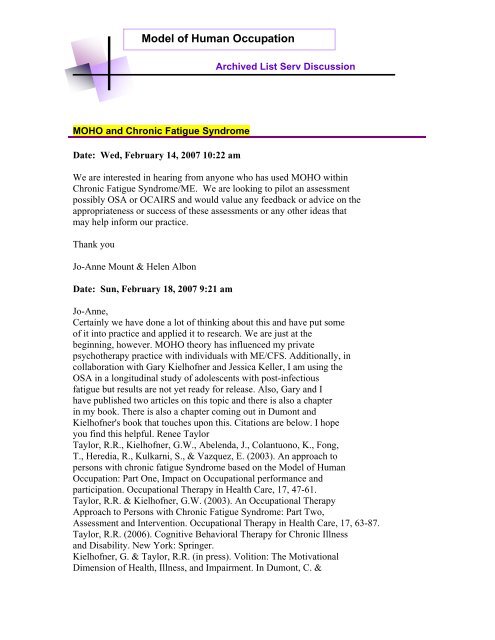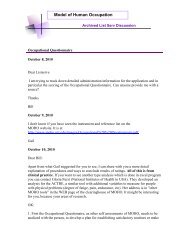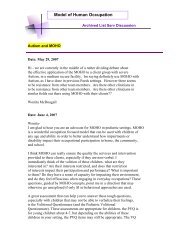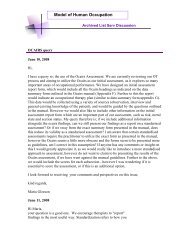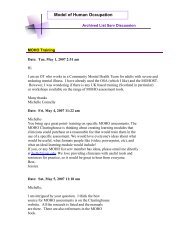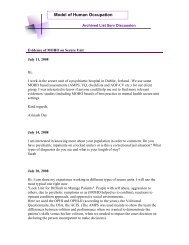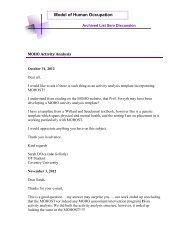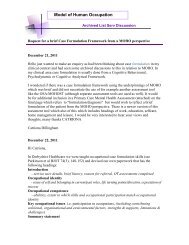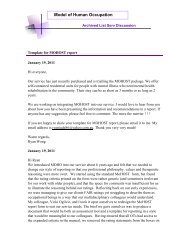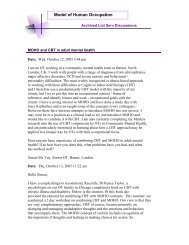MOHO and Chronic Fatigue Syndrome
MOHO and Chronic Fatigue Syndrome
MOHO and Chronic Fatigue Syndrome
You also want an ePaper? Increase the reach of your titles
YUMPU automatically turns print PDFs into web optimized ePapers that Google loves.
Model of Human Occupation<br />
Archived List Serv Discussion<br />
<strong>MOHO</strong> <strong>and</strong> <strong>Chronic</strong> <strong>Fatigue</strong> <strong>Syndrome</strong><br />
Date: Wed, February 14, 2007 10:22 am<br />
We are interested in hearing from anyone who has used <strong>MOHO</strong> within<br />
<strong>Chronic</strong> <strong>Fatigue</strong> <strong>Syndrome</strong>/ME. We are looking to pilot an assessment<br />
possibly OSA or OCAIRS <strong>and</strong> would value any feedback or advice on the<br />
appropriateness or success of these assessments or any other ideas that<br />
may help inform our practice.<br />
Thank you<br />
Jo-Anne Mount & Helen Albon<br />
Date: Sun, February 18, 2007 9:21 am<br />
Jo-Anne,<br />
Certainly we have done a lot of thinking about this <strong>and</strong> have put some<br />
of it into practice <strong>and</strong> applied it to research. We are just at the<br />
beginning, however. <strong>MOHO</strong> theory has influenced my private<br />
psychotherapy practice with individuals with ME/CFS. Additionally, in<br />
collaboration with Gary Kielhofner <strong>and</strong> Jessica Keller, I am using the<br />
OSA in a longitudinal study of adolescents with post-infectious<br />
fatigue but results are not yet ready for release. Also, Gary <strong>and</strong> I<br />
have published two articles on this topic <strong>and</strong> there is also a chapter<br />
in my book. There is also a chapter coming out in Dumont <strong>and</strong><br />
Kielhofner's book that touches upon this. Citations are below. I hope<br />
you find this helpful. Renee Taylor<br />
Taylor, R.R., Kielhofner, G.W., Abelenda, J., Colantuono, K., Fong,<br />
T., Heredia, R., Kulkarni, S., & Vazquez, E. (2003). An approach to<br />
persons with chronic fatigue <strong>Syndrome</strong> based on the Model of Human<br />
Occupation: Part One, Impact on Occupational performance <strong>and</strong><br />
participation. Occupational Therapy in Health Care, 17, 47-61.<br />
Taylor, R.R. & Kielhofner, G.W. (2003). An Occupational Therapy<br />
Approach to Persons with <strong>Chronic</strong> <strong>Fatigue</strong> <strong>Syndrome</strong>: Part Two,<br />
Assessment <strong>and</strong> Intervention. Occupational Therapy in Health Care, 17, 63-87.<br />
Taylor, R.R. (2006). Cognitive Behavioral Therapy for <strong>Chronic</strong> Illness<br />
<strong>and</strong> Disability. New York: Springer.<br />
Kielhofner, G. & Taylor, R.R. (in press). Volition: The Motivational<br />
Dimension of Health, Illness, <strong>and</strong> Impairment. In Dumont, C. &
Kielhofner, G. (Eds) Positive Approaches to Health. New York: Springer.<br />
Renee R.Taylor<br />
Date: Mon, February 19, 2007 8:51 am<br />
Dear Helen,<br />
I work in a CMHT in north wales, <strong>and</strong> have used the OCAIRS on 2 people to<br />
date who have CFS as well as moderate / severe depression. I found the<br />
OCAIRS to be very useful in highlighting for the client the specific areas<br />
they need to work on as well as having a nice easy way of showing change. I<br />
did use it in conjunction with a number of othere assessments <strong>and</strong> tools.<br />
1. The volitional questionnaire<br />
2.Social functioning scale<br />
3. DAS - dysfunctional attitude scale?<br />
4. As well as using negative / rational though response diaries.<br />
A part of the treatment has been looking into causation, <strong>and</strong> looking at<br />
'with these 2 clients', the perfectionalist traits that they have, coping<br />
skills enhancement, <strong>and</strong> problem solving has been high.<br />
With a systematic approach to graded activity / exposure both of these<br />
people are back to high levels of functioning. I also worked closely with<br />
the GP <strong>and</strong> both clients were put on high doses of EPA oils.<br />
Hope thats some help<br />
Neil<br />
Date: Mon, February 19, 2007 9:19 am<br />
Helen-<br />
There have been several position papers on <strong>MOHO</strong> <strong>and</strong> CFS. The OSA was an<br />
assessment that was used.<br />
There has also been some qualitative research done on chronic pain using<br />
<strong>MOHO</strong> as a framing theory.<br />
Here are some references you may find useful:<br />
Taylor, R. R. & Kielhofner, G. W. (2003). An Occupational Therapy Approach<br />
to persons with <strong>Chronic</strong> <strong>Fatigue</strong> <strong>Syndrome</strong>: Part two, assessment <strong>and</strong><br />
intervention. Occupational Therapy in Health Care 17[2], 63-88.
Taylor, R. R., Kielhofner, G., Abelenda, J., Colantuono, K., Fong, R.,<br />
Heredia, R. et al. (2003). An approach to persons with <strong>Chronic</strong> <strong>Fatigue</strong><br />
<strong>Syndrome</strong> based on the Model of Human Occupation: Part one, impact on<br />
Occupational Performance <strong>and</strong> Participation. Occupational Therapy in Health<br />
Care, 17 (2), 47-62.<br />
Padilla, R. & Bianchi, E. M. (1990). Occupational therapy for chronic<br />
pain: Applying the model of human occupation to clinical practice.<br />
Occupational Therapy Practice 2[3], 47-52.<br />
Jessica Kramer, MS, OTR/L


